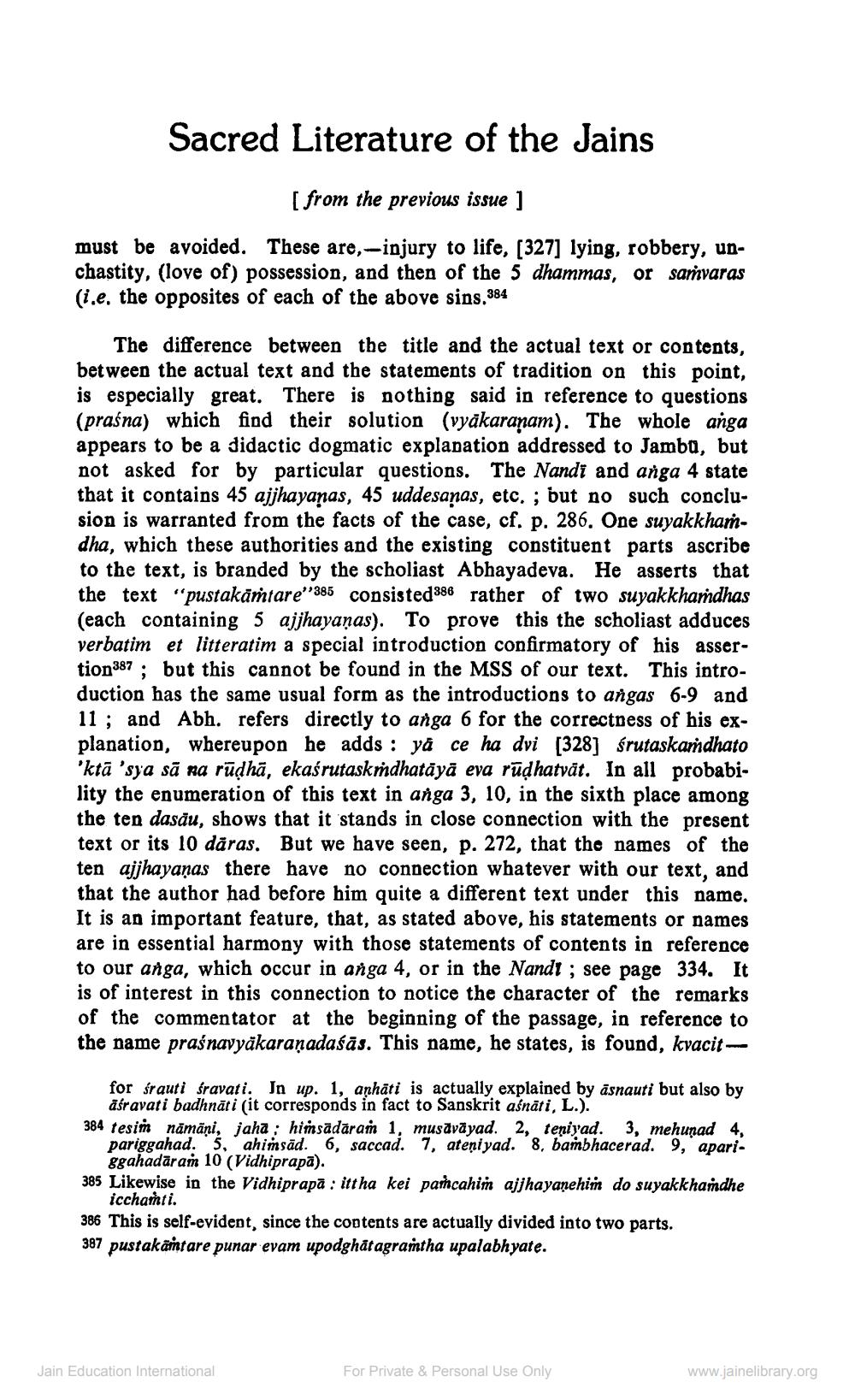Book Title: Jain Journal 1993 01 Author(s): Jain Bhawan Publication Publisher: Jain Bhawan Publication View full book textPage 4
________________ Sacred Literature of the Jains [from the previous issue ] must be avoided. These are,-injury to life, [327] lying, robbery, unchastity, (love of) possession, and then of the 5 dhammas, or saṁvaras (i.e. the opposites of each of the above sins.384 The difference between the title and the actual text or contents, between the actual text and the statements of tradition on this point, is especially great. There is nothing said in reference to questions (praśna) which find their solution (vyākaraṇam). The whole anga appears to be a didactic dogmatic explanation addressed to Jambu, but not asked for by particular questions. The Nandi and anga 4 state that it contains 45 ajjhayanas, 45 uddesanas, etc. ; but no such conclusion is warranted from the facts of the case, cf. p. 286. One suyakkhamdha, which these authorities and the existing constituent parts ascribe to the text, is branded by the scholiast Abhayadeva. He asserts that the text "pustakāṁtare" 385 consisted 886 rather of two suyakkhamdhas (each containing 5 ajjhayanas). To prove this the scholiast adduces verbatim et litteratim a special introduction confirmatory of his assertion387; but this cannot be found in the MSS of our text. This introduction has the same usual form as the introductions to angas 6-9 and 11; and Abh. refers directly to anga 6 for the correctness of his explanation, whereupon he adds: ya ce ha dvi [328] śrutaskaṁdhato 'ktā 'sya sa na rūḍhā, ekaśrutaskṁdhataya eva rūḍhatvät. In all probability the enumeration of this text in anga 3, 10, in the sixth place among the ten dasău, shows that it stands in close connection with the present text or its 10 dāras. But we have seen, p. 272, that the names of the ten ajjhayaṇas there have no connection whatever with our text, and that the author had before him quite a different text under this name. It is an important feature, that, as stated above, his statements or names are in essential harmony with those statements of contents in reference to our anga, which occur in anga 4, or in the Nandi; see page 334. It is of interest in this connection to notice the character of the remarks of the commentator at the beginning of the passage, in reference to the name prasnavyākaraṇadaśās. This name, he states, is found, kvacit― for śrauti śravati. In up. 1, anhāti is actually explained by asnauti but also by äśravati badhnati (it corresponds in fact to Sanskrit aśnāti, L.). 384 tesim nāmāni, jaha; himsādāram 1, musavāyad. 2, teniyad. 3, mehunad 4, pariggahad. 5. ahimsad. 6, saccad. 7, ateniyad. 8, bambhacerad. 9, apariggahadaram 10 (Vidhiprapa). 385 Likewise in the Vidhiprapa: itt ha kei pancahim ajjhayanehim do suyakkhamdhe icchamti. 386 This is self-evident, since the contents are actually divided into two parts. 387 pustakamtare punar evam upodghatagraṁtha upalabhyate. Jain Education International For Private & Personal Use Only www.jainelibrary.orgPage Navigation
1 2 3 4 5 6 7 8 9 10 11 12 13 14 15 16 17 18 19 20 21 22 23 24 25 26 27 28 29 30 31 32 33 34 35 36 37 38 39 40 41 42 ... 57
